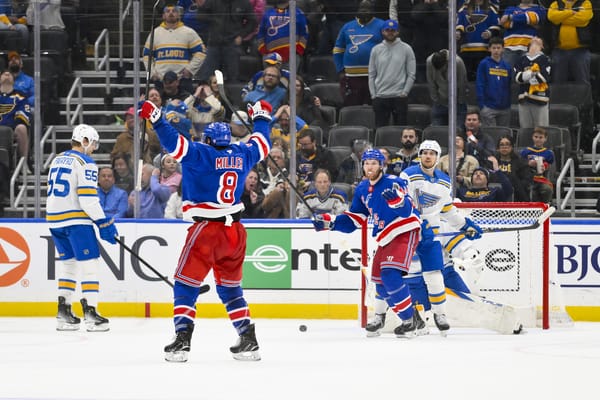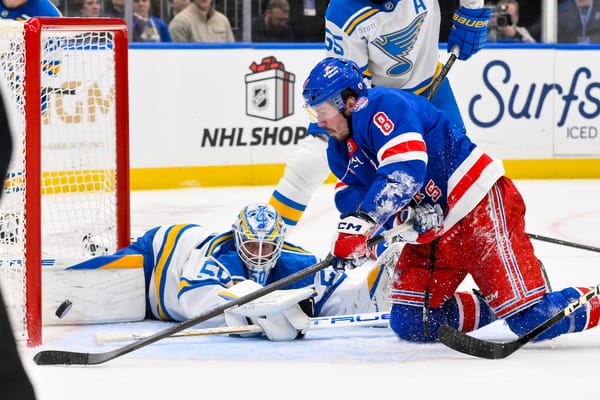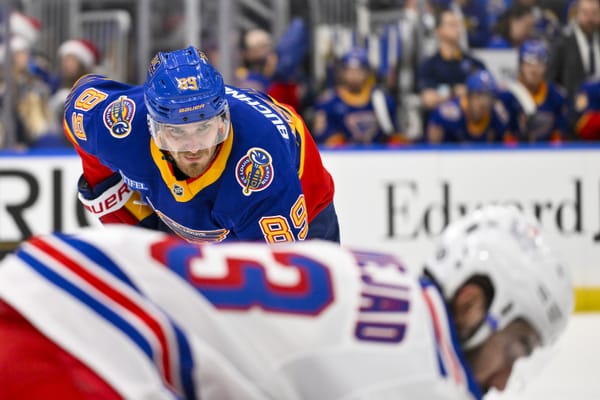Comparing Alexis Lafrenière’s Start With New York Rangers to Kaapo Kakko’s
All eyes were on Alexis Lafrenière when he made his long awaited NHL debut on Madison Square Garden ice almost three weeks ago, much in a similar way fans affixed their gaze to Kaapo Kakko back in October of 2019.
Given each player’s draft status — Lafrenière No. 1 overall in 2020, Kakko No. 2 in 2019 — it feels natural to look at the two and draw comparisons. Both are young players who have the potential to do amazing things for the franchise, although each projects to impact the team in different ways. Take a look at Adam’s past work for more in-depth details on each player, and what each projects to be.
While there are some similarities and differences, I think it is worth evaluating on a base-level how the Rangers’ shiny new toy compares to last year’s model.
For now, let’s stick to 5v5, because the sample of power play time is too small. Plus, I think it is more important to evaluate 5v5 performance since that’s where the majority of the game is played. For time on ice, I am using the game logs from Natural Stat Trick which list each team’s most frequent lines based on TOI spent together.
In Game 1, Lafrenière skated on the left wing alongside Filip Chytil and Julien Gauthier for 4:21, with Brett Howden taking a spin between both wingers for 0:40. In Game 2, Lafrenière moved up the lineup to join Ryan Strome and Artemiy Panarin, and the duo logged 8:45 at evens. He skated with the trio again in Game 3, this time logging 11:28. Then, Lafrenière got a promotion to the top line with Chris Kreider and Mika Zibanejad, and he skated 9:19 in Game 4. He also logging 10:13 in Game 5 with the same set of linemates.
Cumulatively, Lafrenière has skated in five games to date, and logged 67:19 of ice time at 5v5. During that time he’s posted a slash line that includes a 51.54 CF%, a 46.9 xGF%, a 33.09 GF%, and a 44.01 SCF% via Natural Stat Trick. He’s taken five shots on goal, but he’s failed to register a point thus far. The rookie’s had his chances to tally points, and here’s an example of how close he came to scoring his first NHL goal on Sunday January 24 vs. the Penguins.
Lafreniere so close to getting his first pic.twitter.com/3ahyXZSQlW
— Rangers on MSG (@RangersMSGN) January 25, 2021
So while he’s not contributed any offense on the score sheet, the underlying numbers are good and he’s looked engaged for the Rangers. He’s still adjusting to the speed and size of the NHL game, but in due time he’s going to get in sync.
Brett Lee, a video editor for the Maple Leafs, and writer at Canucks Army and The Coaches Site looked at Lafrenière’s first three games, and here’s a sample of what he found.
ICYMI I broke down Alexis Lafrenière's first 3 NHL games in my latest video!
— Brett Lee (@MirokiOnDefence) January 23, 2021
His success rate with the puck in the offensive zone has clear room to improve but his transition game has looked pretty seamless so far.
Watch here: https://t.co/csdxEbQ7Y1 pic.twitter.com/IHI6snhHMl
Lafrenière will be rewarded eventually, and once he starts shooting the puck more he’ll be in good shape. This isn’t a problem exclusive to him, as many Rangers have gotten too cute looking for the perfect play. The end result has often been a skater making one pass too many, with a shot on goal opportunity being squandered. I’ve joked about it, but is there something to be said about fans not being in the stands to yell shoot? Probably not, but I’d like to believe there is.
What is notable is that he got a start on the third line with a good center in Chytil, and another young forward in Gauthier. It was a combo I wish stayed together a little longer, but head coach David Quinn moved the rookie up with Panarin and Strome, and decided that Julien Gauthier needed to come out of the lineup, so the trio was short lived. And as we’ve seen the last two games, he’s also played on the top line with Kreider and Zibanejad — two veteran players who are struggling mightily.
All of this to say is that Lafrenière is currently contributing himself, and it isn’t a case of him riding coattails. Yes, he’s played with good talent, but he doesn’t at all appear like he’s drowning of failing to tread water.
With that said, how does he compare to Kakko?
Kaapo Kakko made his NHL debut on a line with Chris Kreider and Ryan Strome in October of 2019 and logged 10:19 at 5v5. He stayed with the same linemates in his second career game skating 6:10, although Brendan Lemieux subbed in for Kreider for 3:30. Game 3 saw him reunited with Kreider and Strome for 6:28, although Brett Howden subbed in for 2:57.
Game 4 saw a new line of Kreider, Howden, and Kakko skate 5:57, with Jesper Fast making an appearance in place of Kreider for 0:09. Lastly, Kakko’s fifth game saw Pavel Buchnevich flank him on the left, with Howden in the middle for 4:55.
Cumulatively, Kakko logged 61:37 of ice time at 5v5 and posted a slash line that includes a 41.22 CF%, a 21.45 xGF%, a 33.33 GF%, and a 32.76 SCF%. He took five shots on goal, with one ending up in the back of the net for his lone NHL point coming vs. the Edmonton Oilers.
Kaapo Kakko scores his first NHL goal 🚨 #NYR pic.twitter.com/GWMy5PVyIa
— Shayna (@hayyyshayyy) October 12, 2019
So in short, Lafrenière has a significant edge analytically in his first five games compared to Kakko, but it needs to be said that the circumstances aren’t the same. Lafrenière was older to start his NHL career — because the pandemic delayed things — and his games have been played against the New York Islanders, New Jersey Devils, and Pittsburgh Penguins because play this season is divisional only. Plus, the Rangers were a tire-fire defensively to start 2019-20, although interestingly enough Kakko played in front of .955 goaltending, whereas Lafrenière’s had .866 thus far. Kakko’s PDO was 99.4, and Lafrenière’s is currently at 93.2, albeit a small sample.
Kakko was one of the youngest players in the league upon making his debut — while adjusting to life in North America — and he played vs. the Winnipeg Jets, Ottawa Senators, Edmonton Oilers, New Jersey Devils, and Washington Capitals. He also wasn’t playing with someone who draws attention like Panarin or Zibanejad, but it wasn’t like he was driving play himself; something that became evident as the season went on.
But what is important to note is that Kakko’s start to this season has been much better, as he’s boasting a slash line featuring a 53.64 CF%, a 41.21 xGF%, a 50.88 GF% and SCF% of 47.51. He’s also found the back of the net twice, and has taken eight shots in five games played.
The third line gets to work and Kakko makes it 4-0 #NYR pic.twitter.com/hiAZ2cnm9o
— Shayna (@hayyyshayyy) January 17, 2021
The sample analyzed in both cases was just five games, and while small in nature, it is worth noting that it represents five of the nine games a player on an entry-level deal can suit up for before the first year of their contract is burned. This is not to say that the Rangers were ever going to let Lafrenière or Kakko slide, but in the case that they ever did consider doing so, five games would have been an important amount of data for the team.
While this story could have probably waited a few more games, I wanted to write something now given how the Rangers started off moving each player around at the start, before eventually settling on a combination. That seemed to be quicker for Lafrenière than Kakko, but close enough, I guess?
We will learn more about Lafrenière as his season continues, but fans shouldn’t be concerned with how he’s played, or the fact that he hasn’t scored. Likewise, fans should look to Kakko’s rough start last season, and should be encouraged that he appears to be “figuring things out”.
When the 2019-20 campaign was all said and done, Kakko finished with 12 goals, and 13 assists for 25 points in 71 games (0.35 points per game) although the underlyings were atrocious.
Lafrenière has 51 games left, and if he were to match Kakko’s production on a per game basis, he’d need to tally 20 points which seems more than doable. But as was said last year, and will continue to be said: it isn’t all about points. It’s about being able to drive play and generate chances, and eventually, to play in all three zones.
Look no further than the development we’ve seen from Pavel Buchnevich who was a third-rounder that joined the Rangers after some time in the KHL and AHL. Defensively he’s grown leaps and bounds, and this year he’s been one of the team’s better overall players. This is to say that if someone without pedigree figured it out, players like Kakko and Lafrenière can too. That’s where someone like head coach David Quinn can/should come in, especially since developing players was a selling point for his hiring.
Lafrenière to his credit has looked more than OK for a rookie, and you just get the sense that once he gets his first goal, the flood gates are going to open for him. Just for context, here’s some of the notable rookie forwards in the league, some among the scoring leaders, and how their underlyings compare to Lafrenière.
He’s a really smart and talented offensive player, and if there’s a word or two I’d use to describe his start it is selfless and hesitant. Once he gets a little more assertive taking the shot or driving in smartly as opposed to looking to set someone else up, look out. There’s been flashes of it, and by and large there’s evidence in a small sample to indicate he’s on the right track.
As last season went on that didn’t happen with Kakko, and there’s many reasons why things went wrong, but it is good to see so far things have been different for him this year. So in short, the kids are alright. It is early, the hockey has been weird, and the limited schedule and fixed opponents will make it hard to evaluate some things, but there is no reason to worry about Lafrenière.
Stats via Natural Stat Trick unless otherwise noted.





